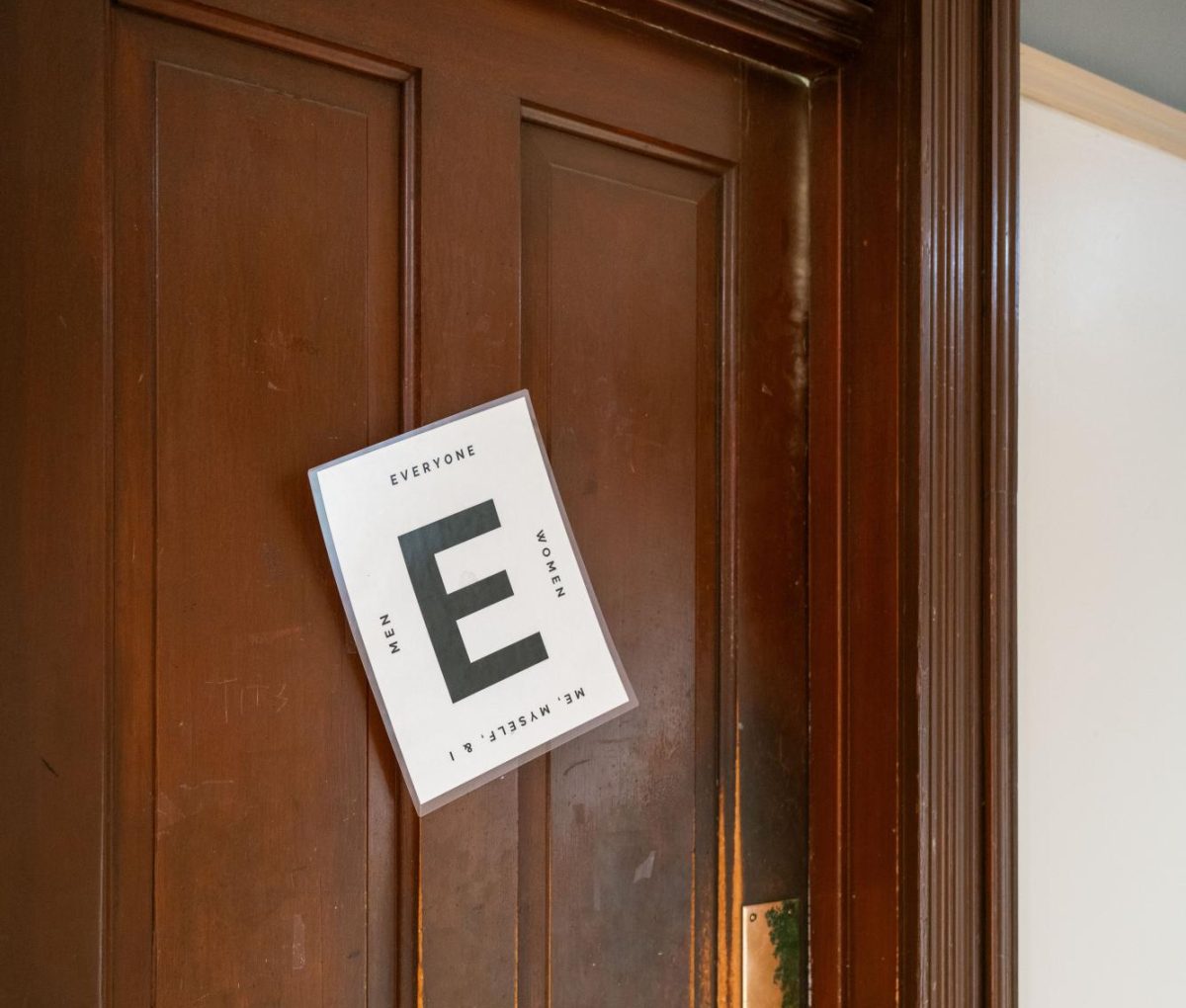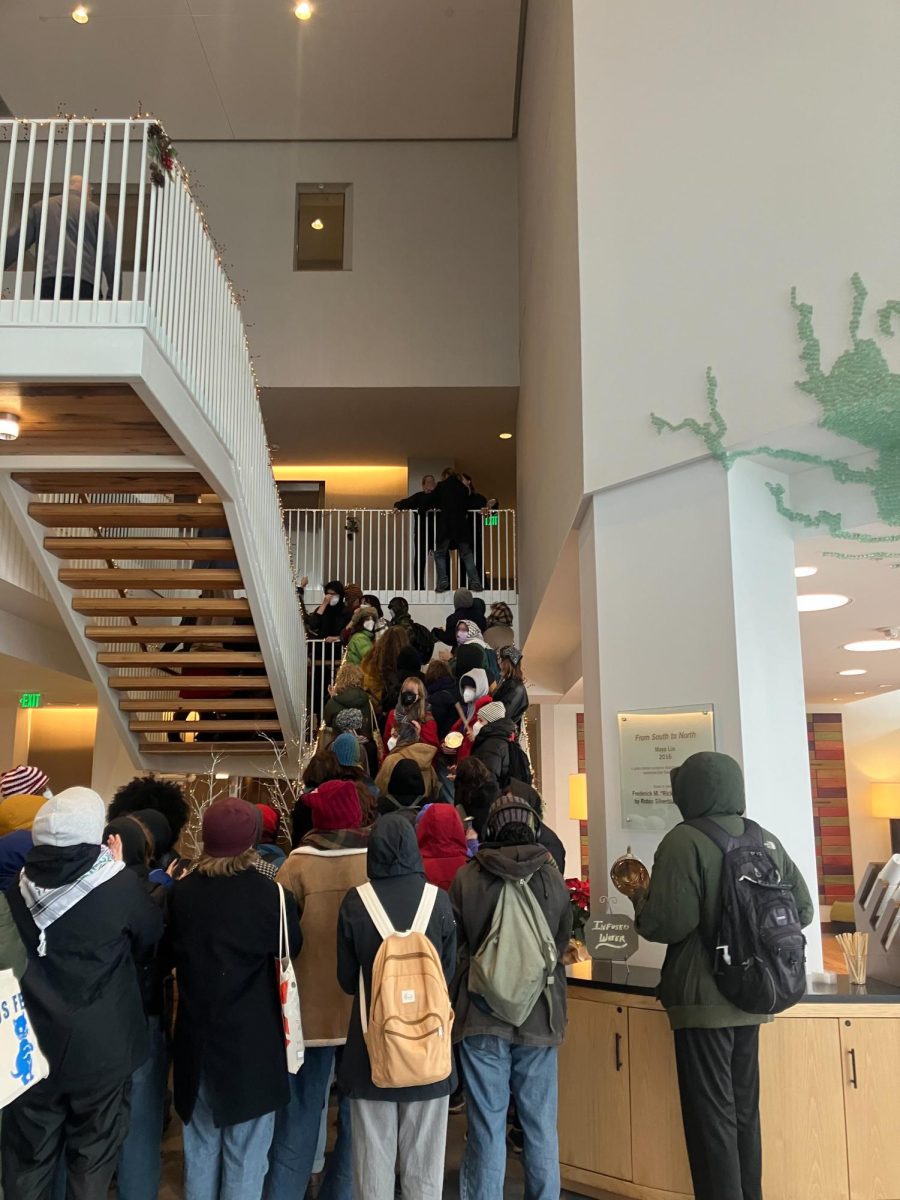The Mechanics of Self-Creation, Abstraction, and Feedback in AUTOPOIESIS
May 3, 2013
College seniors Thomas Huston and Ryan Caruso created an elegant amalgamation of work in their senior studio show AUTOPOIESIS: an exhibition of electronic abstractions. The show took place in Hales Gymnasium, creating a subtle and compatible backdrop for the work with the aged, retro atmosphere of the old gymnasium. The vastness and airy quality of the room, as well as the artworks’ free-standing placement throughout the space, created an atmosphere somewhat like the Park Avenue Army in New York City. The visitor was able to move through the space comfortably and uninhibitedly, able to view the art from all angles and distances.
Autopoiesis as defined by the Web Dictionary of Cybernetics and Systems, is “the process whereby an organization produces itself, …an autopoietic system [that] is operationally closed and structurally state determined with no apparent inputs or outputs.” The term thoroughly fit both bodies of work, which constructed self-referential systems of creation and presentation. For Huston’s prints, he worked mainly with a multi-purpose desktop scanner and printer in an attempt to reconcile his interest in the contemporary culture of the digital image with a more direct and hands-on artistic process. Caruso worked with old and outdated technology to create feedback loops between one or multiple systems, ultimately manipulating the technologies’ output of display and sound.
To create his images, Huston began by scanning and copying a crumpled or otherwise physically altered piece of paper. He then used the copy to create a new image printed on the original scanned sheet. While continuing this process, the pieces of paper were further manipulated by Huston while in the printer, or naturally encountered jams from the repeated application of thick ink. The end result is an abstracted, digital, multimedia painting. In the final prints, the viewer can distinguish the thickness of ink from layer upon layer of copied image, yet the physicality of its application is eliminated, as it becomes one digitally printed image, an amalgamation and compression of repetitious layering.
Just as the ultimate medium is confused in Huston’s creation, the origin of material cannot be found. As copy and original are both used multiple times, to then copy themselves and each other, the process becomes not only about self-creation but also of a constantly updated record of progress and change. The final product of this physio-mechanical process is not merely one of self-generation but also of constantly shifting feedback. There is no moment of stasis or consistency in Huston’s process, as the copied images become physical maps of the object’s personal history. The only static object is the final print, where dancing lines show mechanical glitches, abstract formations of color and black ink work as evidence of repetitious layering, and a chaos of jagged shapes from physical alteration are distilled in a single abstract chronicle. It is precisely this absence of origin and subversion of the creator that brings the magic and depth to Huston’s work. Who, or what, created these images and what do they physically contain?
Caruso’s work, while perhaps easier to explain, can only be truly understood to the few adept individuals who understand the physical inner workings of media-based technology. Backless or partially dismantled televisions, stripped speakers, transmitters, radios and surveillance systems make up the physical structure of his pieces, which were set up on tables and pedestals. throughout the space. Because of this, the viewer was able to examine the machines, their structure, and their interconnectivity from all angles. One of the most striking of Caruso’s pieces was an intricate setup consisting of a Sony surveillance system, a machine made up of eight identical small screens and dials with shifting horizontal and vertical lines across the screens, bending out of shape or experiencing technological glitches with a constant rhythm. Next to this was a setup of two generators connected to a small TV-radio, partially split open and tipped on its side. On the screen a strange light feedback danced, a play of energy. The rhythm in light display on both machines echoed with the feeling of a heartbeat. The palpable energy was recognizable as one of machine origin, but with a pattern that began to resemble human life more than anything else.
In an almost enclosed structure in the center of the room, three small televisions stood on pedestals, showing displays of static or of INPUT modes. On the floor in front of were five speaker heads, three of which were rising and falling with a vibrating pulse. The speakers were mesmerizing, at once organic and mushroom-like, recalling ideas of nature as well as the internal human body. They were lifelike in many ways, yet moving with a vibration that was so very mechanical. Caruso’s pieces are fully self-contained, closed systems. Their input is their output, their final product dependent on their own internal functionality or pending collapse.
Together, Huston and Caruso’s work came to represent different moments of a similar process. Where the viewer is witness to the live-action current of feedback in Caruso’s work, Huston freezes this dance of mechanical energy into a single composite image. In their bodies of work both artists question origin and control, and the viewer ultimately is forced to ask: Who is the artist and what are we viewing? Are these pieces abstract representations of feedback, or are we witnessing a live manifestation of the aesthetic processes of these various machines?






















